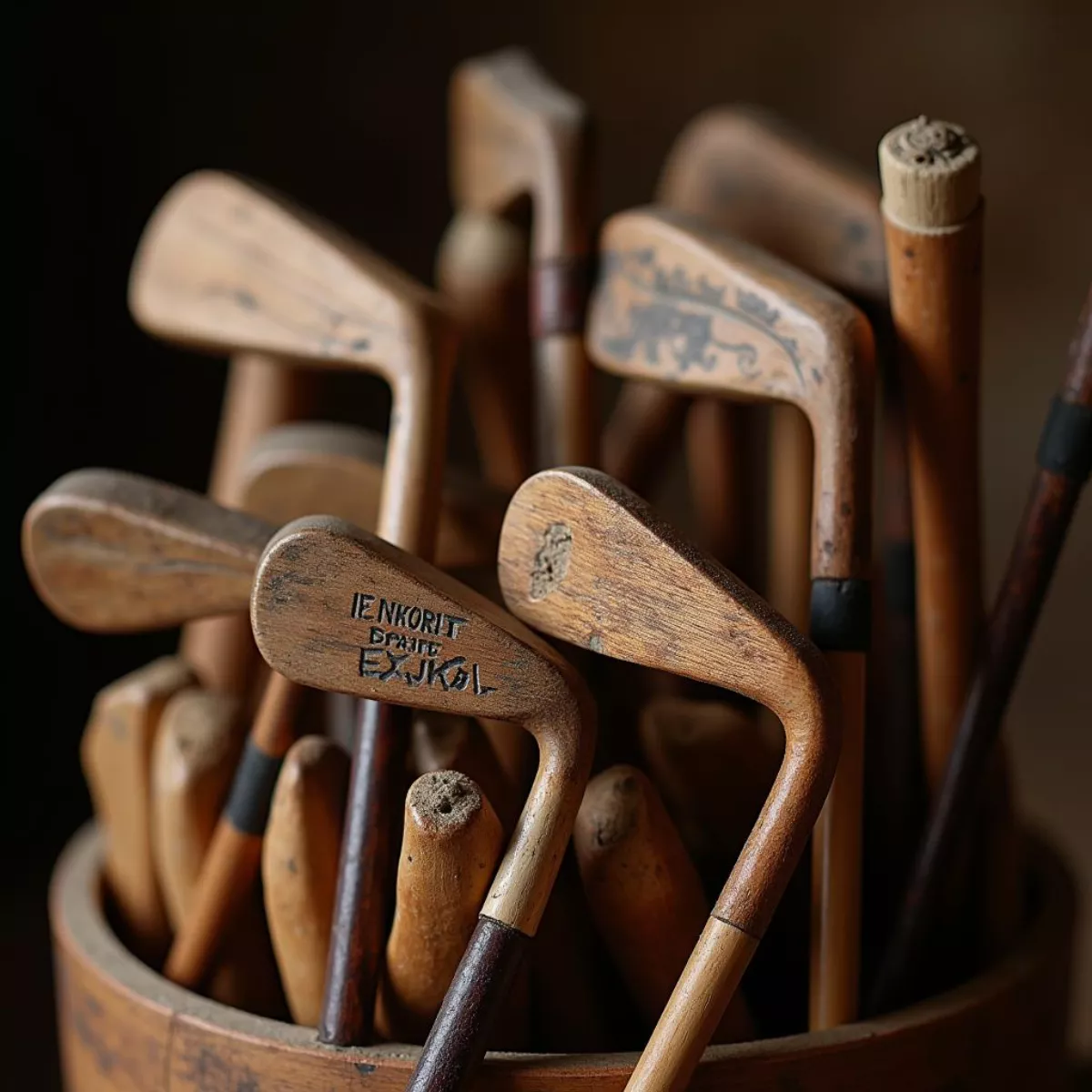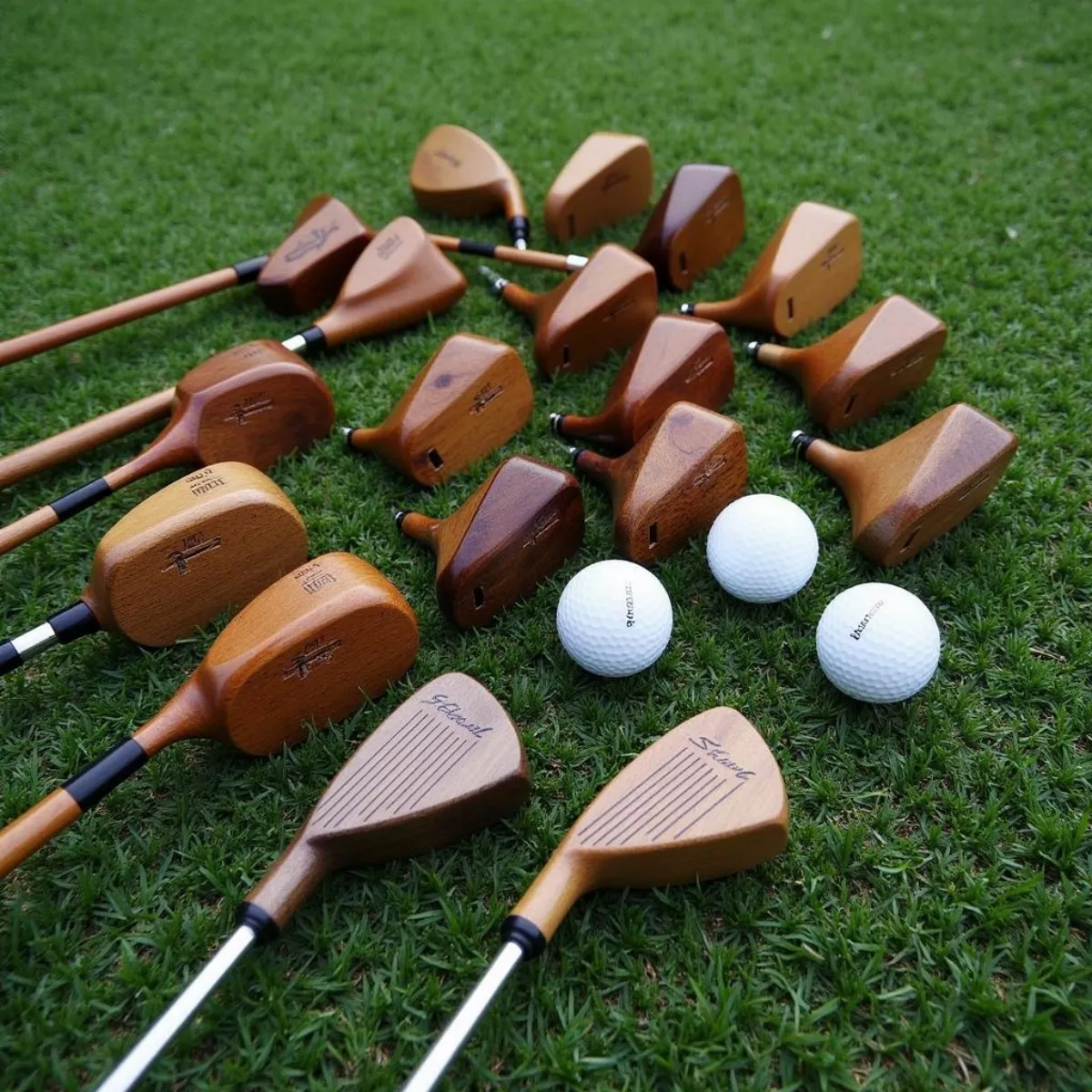Golf is a sport rich in history, and one of the most fascinating aspects of this history is the evolution of golf clubs, particularly wooden clubs. Today, we see a vast array of golf equipment made of various materials, but understanding the significance of wood in golf provides insight into the sport’s development and can even improve your game.
The Historical Context of Wood in Golf
The Origins of Golf Clubs
Did you know that golf dates back to the 15th century? The game was played with simple sticks, but with time, the need for more sophisticated equipment emerged. Early golf clubs were made of wood, primarily from various native tree species.
- Ash and Pear: These woods were the most common materials for club heads. Their density provided a better striking surface and durability.
- Hickory: This strong and flexible wood was favored for shafts because it could withstand the force of impact while still being lightweight.
 Early Golf Clubs Made of Wood
Early Golf Clubs Made of Wood
Transition to Modern Materials
By the late 20th century, technology had advanced, leading to the incorporation of materials like graphite and stainless steel. However, the essence of wood in golf clubs remains significant, particularly when it comes to the driver.
Types of Wooden Clubs
Understanding the different types of golf clubs made of wood is crucial for better gameplay. Let’s explore the primary categories:
1. Drivers
The driver is arguably the most iconic wood club in a golfer’s bag. Traditionally, drivers were crafted from wood, but modern variations often use composite materials. However, the classic wooden flush still invokes fond memories for many players.
- Material: Typically made from maple or mahogany, giving a solid but forgiving striking surface.
- Design: Newer drivers focus on aerodynamics and sweet spot size, but wood retains its charm and feel for dedicated players.
2. Fairway Woods
These clubs are used for longer shots from the fairway and are typically numbered (3-wood, 5-wood, etc.). Fairway woods were historically made of wood, providing versatility in handling various conditions.
- Design: Featuring a shallower face compared to drivers, fairway woods allow for better performance on the grass.
- Construction: Commonly made of maple, cherry, or persimmon, each wood provides unique performance characteristics.
 Different Types of Wooden Golf Clubs
Different Types of Wooden Golf Clubs
3. Hybrids
While not purely wood, hybrids often combine a wood-like design with the performance of iron clubs. They’re designed to tackle tough lies and can be more forgiving than traditional long irons.
The Advantages of Using Wooden Clubs
Even in today’s high-tech golfing realm, many golfers still appreciate the advantages of using traditional wooden clubs:
- Feel: Wooden clubs provide a unique feel and feedback upon impact, which many seasoned players prefer.
- Weight Distribution: The natural weight of wood can enhance the golfer’s swing, leading to better control and accuracy.
- Tradition: There’s a rich history associated with wooden clubs that offers a sentimental value, connecting players to the origins of the game.
Maintenance Tips for Wooden Clubs
If you’re lucky enough to own and use wooden clubs, you need to care for them properly to preserve their functionality and appearance. Here are some maintenance tips:
- Cleaning: Use a damp cloth to wipe down the club after each round. Avoid submerging them in water.
- Storage: Keep them in a cool, dry place to avoid warping.
- Repairs: Inspect the clubs regularly for cracks or dents, which can affect performance. Seek professional repairs when necessary.
Modern Innovations in Wooden Club Design
While wooden clubs have a classic appeal, manufacturers are continuously innovating to enhance their performance:
- Composite Materials: Some drivers and fairway woods now feature advanced composite materials combined with traditional wood, offering the best of both worlds.
- Vibration Dampening Technology: Modern wood clubs may include technology that minimizes vibrations, improving feel and control on impact.
- Adjustability: High-tech wooden clubs can now be adjusted for loft and lie, giving players the ability to tailor their equipment to their individual swing patterns.
Key Takeaways
- Wooden clubs carry historical significance in golf, giving insight into the game’s evolution.
- Types of wooden clubs include drivers, fairway woods, and hybrids, each serving a specific purpose on the course.
- Advantages of wooden clubs include their unique feel, weight distribution, and connection to golf’s roots.
- Proper maintenance of wooden clubs can greatly extend their lifespan and performance.
- Modern innovations are bringing composite materials and technologies to enhance wooden clubs.
FAQ: All About Wooden Clubs in Golf
1. Are wooden clubs still effective in modern golf?
Yes, many golfers still favor wooden clubs for their unique feel and performance, especially in the driver category.
2. What type of wood is commonly used for golf clubs?
Traditionally, woods like ash, pear, hickory, maple, and persimmon are commonly used for making golf clubs.
3. How can I maintain my wooden golf clubs?
Wipe them down after use, store them in a dry place, and inspect them for any damage regularly.
4. Can I use wooden clubs on a golf course today?
Absolutely! While many players opt for metal-club technology, wooden clubs remain a viable and cherished option.
5. Are there any advantages to using hybrid clubs over wooden clubs?
Hybrids provide more forgiveness and are often better suited for tough lies compared to traditional wooden clubs.
6. What are the benefits of using a wooden driver?
Wooden drivers offer a unique feel, good weight distribution, and a sentimental connection to the sport’s history.
7. Can I customize wooden clubs?
Many manufacturers offer customization options, including loft adjustments and grip changes, even for wooden clubs.
8. Do wooden clubs require special treatment?
Yes, they should be handled with care; avoid water exposure and store them properly.
9. How do I choose the right wooden club for my game?
It’s best to consider your swing style, preferred weight, and desired feel. Testing different clubs can also help.
10. Are wooden clubs more expensive than modern ones?
This varies; however, some vintage or limited-edition wooden clubs can be quite expensive.
 Golfer Choosing a Wooden Club
Golfer Choosing a Wooden Club
Conclusion
Whether you’re an avid collector of vintage clubs or someone intrigued by the historical significance, it’s essential to appreciate wooden clubs’ role in golf. They not only impact gameplay but also connect you to the sport’s roots. Understanding these nuances is instrumental in enhancing your golfing experience and expertise. So next time you hit the links, consider giving a classic wooden club a swing—it might just be the refresher your game needs!
This comprehensive guide on wood in golf embraces the essence of tradition while appreciating modern enhancements, emphasizing how both can coexist for an enriched golfing experience.